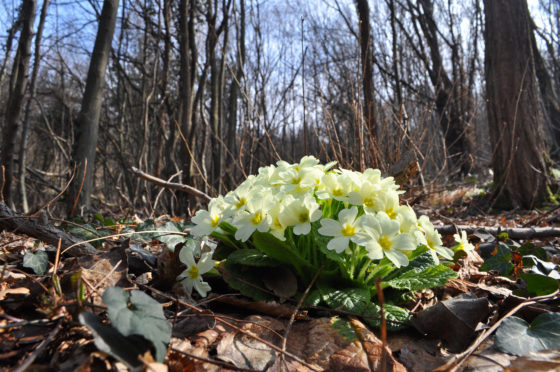Yellow comes in all shades and tints, but there is surely no colour yellow that compares in brightness and vibrancy as that found on the wild primroses now coming into bloom by our waysides and woodland edges.
The primrose delivers such dazzling freshness; little orbs of joyous sunshine signalling that spring is well and truly here and warm balmy days lie ahead. Primrose – prima rosa – the first rose or flower of the year, and one which for generations have been picked as Easter decorations for churches across the land.
Primroses seem to prefer well drained soils and are most prevalent on open woodland banks and by the edges of hedgerows and country lanes. Such early flowering makes it a much sought-after plant by pollinating insects in search of sweet nectar, with their bright yellow flowers acting like little beacons. For insects, a sun-glowed clump of primroses on the bare woodland floor is an oasis, a provider of life.
But other flowers are emerging too; indeed, as I slowly walk through my local wood in Strathdevon the ground below my feet is undergoing a remarkable transformation. The verdant green, elongated leaves of wild garlic, or ramsons as they are known, are unfurling and soon their blousy dome-shaped white blooms will burst into flower.
Stinky nanny is one old country name for the ramson – but how inappropriate, for I just love the subtle garlicky aroma that tinges our woodland air at this time of year. They can form very dense colonies, but ramsons are fickle in their distribution, being abundant in some woods and totally absent in others.
By the banks of a tumbling woodland burn, splashes of lemon and limey-green hues catch my eye, a citrus palette of merging colour. It is a creeping mat of opposite-leaved golden saxifrage, a real tongue-twister of a name, but a marvellous and rather under-stated spring flower for all that. Their golden-green flowers are truly miniscule but are so exquisite and intricate in their construction. The naturalist Richard Mabey once described these wonderful plants as being like ‘trickles of gold on shady stream-banks”.
Dog violets, stitchwort and so many other wildflowers are also now on the cusp of their very being, making this a season to savour. I hear a woodpecker drumming on the hollow bough of a tree; a chiffchaff, just newly arrived from Africa, delivers its repetitive two-tone call. Some describe the chiffchaff’s song as being rather monotonous, but I’m not so sure, for it is a tune of hope for the breeding season that lies ahead.
Besides, this chiffchaff is the herald for several other types of warbler that will be arriving on our shores over the coming weeks. It is the willow warbler I look forward to most, its sweet cascading song hypnotic in quality; the kind of music that gently releases all tension from within the inner soul, relaxing the mind in a way few other sounds can.
Info
Primroses sometimes cross with the closely related cowslip. In Courier Country, cowslips can often be found growing on coastal grasslands, such as at Elie in Fife or the Seaton Cliffs near Arbroath.
